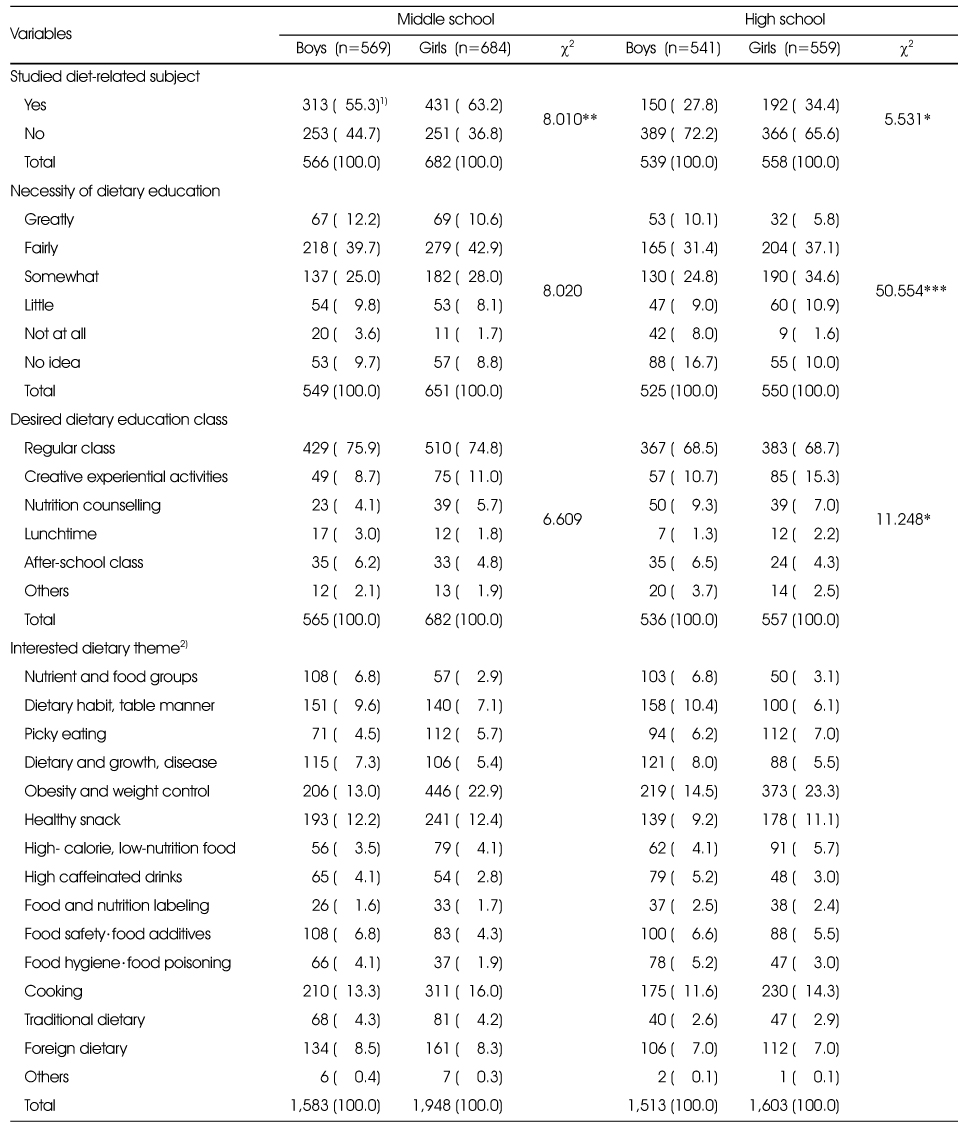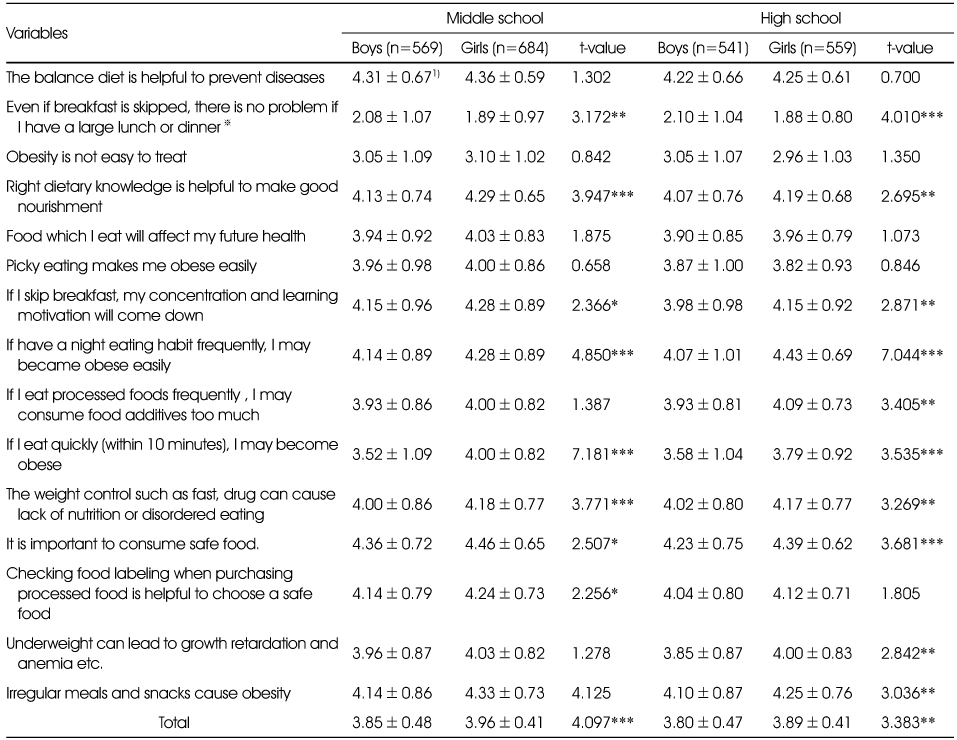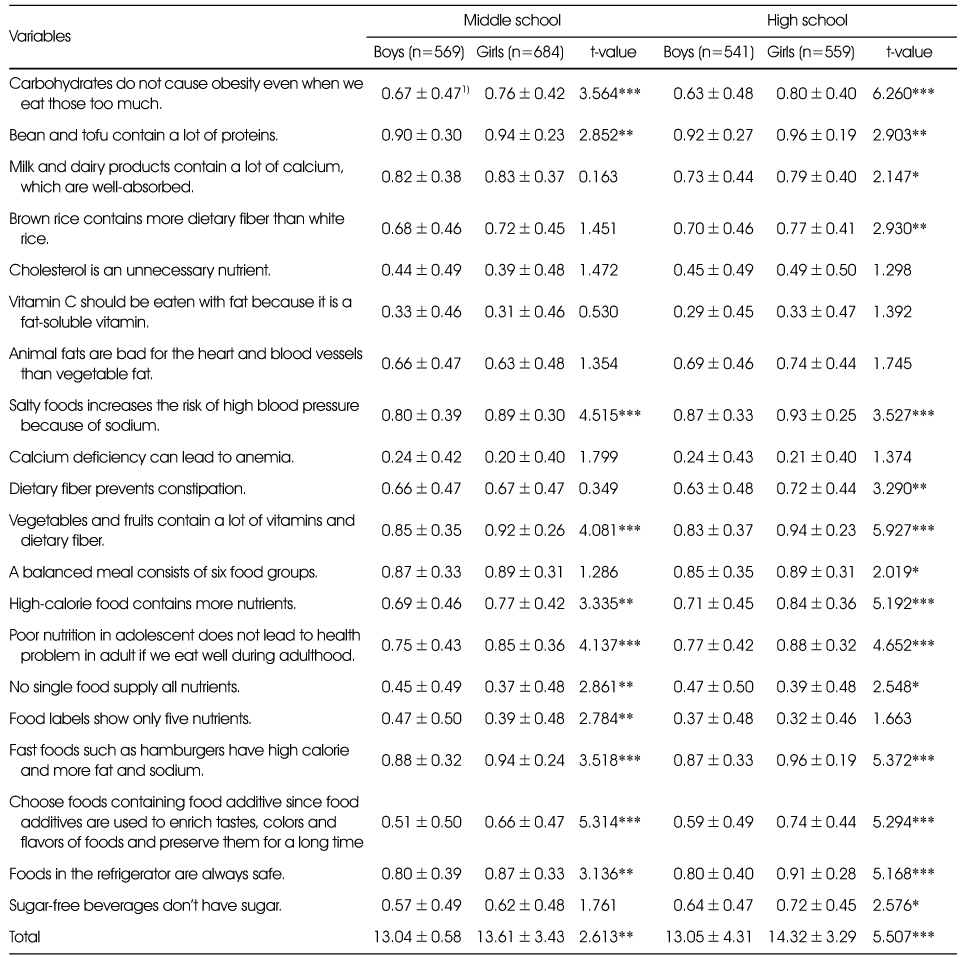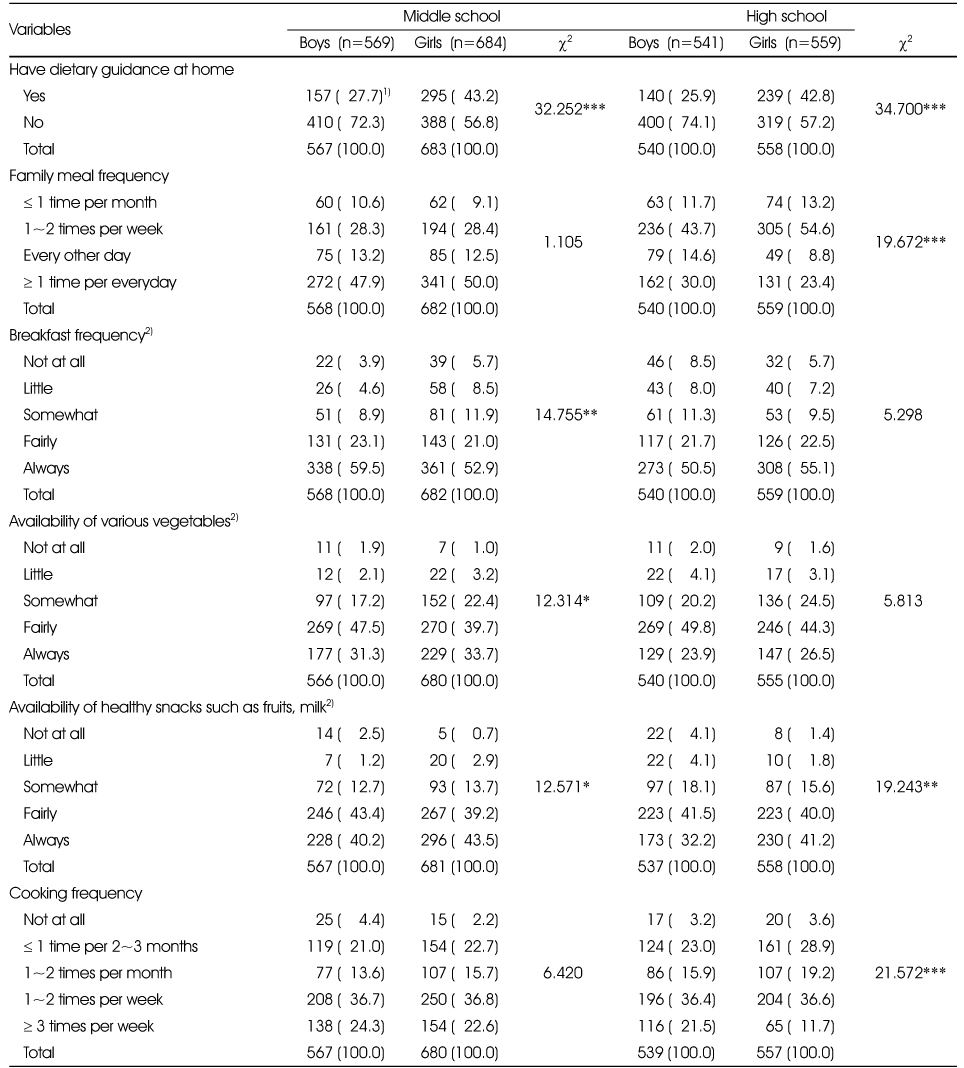Articles
- Page Path
- HOME > Korean J Community Nutr > Volume 21(2); 2016 > Article
-
Research Article
- Gender Differences in Adolescents' Dietary Perceptions and Practices
-
Taejung Woo, Hye-Jin Lee, Kyoung Ae Lee, Seung Min Lee, Kyung-Hea Lee

-
Korean Journal of Community Nutrition 2016;21(2):165-177.
DOI: https://doi.org/10.5720/kjcn.2016.21.2.165
Published online: April 30, 2016
1Department of Food and Nutrition, Changwon National University, Changwon, Korea.
2Department of Practical Arts Education and Centre for Child Nutrition Education, Busan National University of Education, Busan, Korea.
3Department of Food and Nutrition, Sungshin Woman's University, Seoul, Korea.
- Corresponding author: Kyung-Hea Lee. Department of Food and Nutrition, Changwon National University, 20 Changwondaehakro, Uichang-gu, Changwon, Gyeongnam, 51140, Korea. Tel: (055) 213-3514, Fax: (055) 281-7480, khl@changwon.ac.kr
Copyright © 2016 The Korean Society of Community Nutrition
This is an Open-Access article distributed under the terms of the Creative Commons Attribution Non-Commercial License (http://creativecommons.org/licenses/by-nc/3.0/) which permits unrestricted non-commercial use, distribution, and reproduction in any medium, provided the original work is properly cited.
- 1,434 Views
- 7 Download
- 9 Crossref
Abstract
-
Objectives
- This study attempted to compare adolescents' dietary behaviors and perceptions by gender in order to recommend useful strategies for nutrition interventions.
-
Methods
- Subjects were 2,363 middle school (MS) and high school (HS) students. They completed a self-administered questionnaire on their interest in diet and health, dietary perceptions, nutrition knowledge, dietary practices, and dietary environment at home. Data were analyzed using t-test, χ2-test, and simple regression analysis by gender and by school groups.
-
Results
- Overall, girls obtained higher scores than boys did for "interest" (MS: p<0.001; HS: p<0.01), "dietary perceptions" (MS: p<0.001; HS: p<0.01), and "knowledge" (MS: p<0.01; HS: p<0.001). Regarding "dietary practices," no gender differences were observed among MS students, however, among HS students, boys obtained higher scores-reflecting good practices-than girls did (p<0.01). In all subjects, dietary environment at home was strongly associated with dietary practice than other variables (MS boys: β=0.435, p<0.001; MS girls: β=0.492, p<0.001, HS boys: β=0.271, p<0.001; HS girls: β=0.429, p<0.001).
-
Conclusions
- We observed gender differences in some of the variables such as knowledge and perception among adolescent students. Educational programs and core strategies that consider these gender differences need to be developed. Specifically, for girls, educational programs should focus on facilitating dietary recommendation adherence, whereas for boys, the program could focus on improving dietary knowledge and perceptions.
Acknowledgments
Acknowledgments
- 1. Golmakani N, Naghibi F, Moharari F, Esmaily H. Health promoting life style and its related factors in adolescent girls. J Midwifery Reprod Health 2013; 1(1): 42-49.
- 2. Spratt J, Shucksmith J, Philip K, Watson C. Part of who we are as a school should include responsibility for well-being: links between the school environment, mental health and behavior. Pastor Care Educ 2006; 24(3): 14-21.
- 3. Sung CJ. A comparative study of food habits and body satisfaction of middle school students according to clinical symptoms. J Korean Soc Food Sci Nutr 2005; 34(2): 202-208.Article
- 4. Lee JS, Yun JW. A study on perception about body image, dietary attitude, dietary self-efficacy and nutrient intake of high school students in Busan. J Korean Soc Food Sci Nutr 2003; 32(2): 295-301.Article
- 5. Ministry of Health and Welfare, Korea Centers for Disease Control and Prevention. Korea Health Statistics 2014 Korea National Health and Nutrition Examination Survey (KNHANES VI-2) [internet]. Ministry of Health and Welfare Korea Centers for Disease Control and Prevention; 2015; cited 2016 Jan 10]. Available from: http://knhanes.cdc.go.kr/.
- 6. Ministry of Education, Science and Technology, Ministry of Health and Welfare, Korea Centers for Disease Control and Prevention. 2015 Korean Youth Risk Behavior Web-based Survey [internet]. Ministry of Health and Welfare Korea Centers for Disease Control and Prevention; 2015; cited 2015 Dec 29]. Available from: http://knhanes.cdc.go.kr/.
- 7. Lee YS, Lim HS, Ahn HS, Jang NS. Nutrition through the life cycle. Seoul: Kyomunsa; 2011. p. 281.
- 8. Jo JE, Park HR, Jeon SB, Kim JS, Park GE, Li Y. A study on relationship between socio-demographic factors and food consumption frequencies among adolescents in South Korea. Korean J Community Nutr 2013; 18(2): 165-176.Article
- 9. Croll JK, Neumark-Sztainer D, Story M. Healthy eating: what does it mean to adolescents? J Nutr Educ Behav 2001; 33(4): 193-198.Article
- 10. Diaz H, Marshak HH, Montgomery S, Rea B, Backman D. Acculturation and gender: influence on healthy dietary outcomes for Latino adolescents in California. J Nutr Educ Behav 2009; 41(5): 319-326.ArticlePubMed
- 11. Kwak SH, Woo TJ, Lee KA, Lee KH. A comparison of dietary habits and influencing factors for vegetable preferences of adolescents in Gyeongnam province. Korean J Community Nutr 2015; 20(4): 259-272.Article
- 12. Bisogni CA, Jastran M, Seligson M, Thompson A. How people interpret healthy eating: contri-butions of qualitative research. J Nutr Educ Behav 2012; 44(4): 282-301.ArticlePubMed
- 13. Yang IS, Lee HY, Kim HY, Kang YH. Setting instructional goals for nutritional education program through an analysis of problems identified in junior/senior high school students. Korean J Community Nutr 2003; 8(4): 495-503.
- 14. Park SH, Park HR, Jeon SB, Jeong SY, Tserendejid Z, Seo JS. Awareness and practice of dietary action guide for adolescence among middle and high school students in Korea. Korean J Community Nutr 2012; 17(2): 133-145.Article
- 15. Contento IR. Nutrition education: linking research, theory and practice. 3th ed. Massachusetts: Jones & Bartlett Learning; 2015. p. 65-66. p. 74. p. 78-79 .
- 16. Chang HS, Roh SM. Comparison with dietary habits, dietary attitudes and nutritional knowledge according to sex of teenagers in Jeonnam province. Korean J Community Nutr 2006; 11(4): 459-468.
- 17. Ministry of Health and Welfare. Dietary guidelines for Korean [internet]. Ministry of Health and Welfare; cited 2014 Jan 20]. Available from: http://www.mohw.go.kr/front_new/.
- 18. Lee EJ. A survey on the snack intake and dietary habits affected by nutrition knowledge of middle school students in Incheon [master's thesis]. Inha University; 2012.
- 19. Kim MN. Adolescent's dietary behaviors, health interest, nutrition knowledge: Its effects on their intakes of nutritional supplements [master's thesis]. Hanyang University; 2013.
- 20. Dewar DL, Lubans DR, Plotnikoff RC, Morgan PJ. Development and evaluation of social cognitive measures related to adolescent dietary behaviors. Int J Behav Nutr Phys Act 2012; 9(36): 1-10.ArticlePubMedPMCPDF
- 21. Park KS, Chun BY, Kam S, Yeh MH, Kang YS, Kim KY. Structural relationships among health concern, health practice and health status of the disabled. Korean J Prev Med 1999; 32(3): 276-288.
- 22. Breslow L, Enstrom JE. Persistence of health habits and their relationship to mortality. Prev Med 1980; 9(4): 469-483.ArticlePubMed
- 23. Lee YJ, Lee HJ, Lee KH. Effects of 16-class nutrition education on middle school students' dietary behavior and nutritional knowledge. Korean J Food Nutr 2014; 27(5): 826-836.Article
- 24. Kang NE, Yoon HR, Kim JH. A Study on the behavior of food hygiene and interest in dietary information according to the level of awareness and practice of food safety. Korean J Food Cult 2013; 28(6): 623-630.Article
- 25. Jung YH, Ko SJ, Lim HJ. The socioeconomic cost of adolescent obesity. Health Soc Welf Rev 2010; 30(1): 195-219.Article
- 26. Sung EJ, Shin TS. The effect of overweight to cardiovascular risk factors among Korean adolescents. J Korean Acad Fam Med 2003; 24(11): 1017-1025.
- 27. Voelker DK, Reel JJ, Greenleaf C. Weight status and body image perceptions in adolescents: current perspectives. Adolesc Health Med Ther 2015; 6: 149-158.PubMedPMC
- 28. Ahn Y, Kim KW. Beliefs regarding vegetable consumption, selfefficacy and eating behaviors according to the stages of change in vegetable consumption among college students. Korean J Community Nutr 2012; 17(1): 1-13.Article
- 29. Choi MK, Bae YJ, Kim MH, In SJ. A survey of the needs of nutrition education based on analysis of eating habits and nutrition knowledge among middle school students in Kyung-Gi province. J Korean Diet Assoc 2010; 16(2): 133-145.
- 30. Choi MY, Kim HY. Nutrition knowledge, dietary self-efficacy and eating habits according to student's stage of regular breakfast or exercise. Korean J Community Nutr 2008; 13(5): 653-662.
- 31. Kim YH. A survey on the nutrition knowledge, dietary behavior and satisfaction of dietary education of high school female students. J Korean Home Econ Educ Assoc 2012; 24(1): 21-36.
- 32. Schwartz NE. Nutritional knowledge, attitudes and practices of high school graduates. J Am Diet Assoc 1975; 66(1): 28-31.ArticlePubMed
- 33. Kim BH, Sung MY, Lee YN. Comparison of the nutrient intakes by the score of dietary action guides for Korean children among the elementary school students in Gwangju city. Korean J Community Nutr 2011; 16(4): 411-425.Article
REFERENCES
Figure & Data
REFERENCES
Citations

- Secular Trends in Dietary Patterns Among Korean Adolescents: Using Data From the 2007–2022 Korea National Health and Nutrition Examination Survey
Eunyoung Tak, Eugene Kang, Minji Kang
Clinical Nutrition Research.2025; 14(4): 270. CrossRef - Development of evaluation items for adolescents’ dietary habits and nutritional practices reflecting eating behaviors and food environment
Jimin Lim, Hye Ji Seo, Jieun Oh
Journal of Nutrition and Health.2024; 57(1): 136. CrossRef - Changes in Ultra-Processed Food Consumption among Adolescents before and after the COVID-19 Pandemic : Using Data from the 7th (2018~2019) and 8th (2020~2021) Korea National Health and Nutrition Examination Survey
Hyun-Jin Hwang, Yoo Kyeong Kim
Korean Journal of Human Ecology.2024; 33(6): 981. CrossRef - Restaurant Meal Delivery and Take-Out Consumption Behavior according to Adolescents’ Food-Related Lifestyles
Yulee Shin, Minsook Kyung, Seonyeong Baek, Sunny Ham
Journal of the East Asian Society of Dietary Life.2021; 31(3): 172. CrossRef - Association between Stress and Nutritional status of High School Students in Chungbuk using Nutrition Quotient for Korean Adolescents
In Young Kim, Mi-Kyeong Choi
Korean Journal of Community Nutrition.2020; 25(5): 361. CrossRef - Development of NQ-A, Nutrition Quotient for Korean Adolescents, to assess dietary quality and food behavior
Hye-Young Kim, Jung-Sug Lee, Ji-Yun Hwang, Sehyug Kwon, Hae Rang Chung, Tong-Kyung Kwak, Myung-Hee Kang, Young-Sun Choi
Journal of Nutrition and Health.2017; 50(2): 142. CrossRef - Nutrition Knowledge, Dietary Attitudes, and Dietary Behaviors by Gender of High School Students in Incheon
Zolzaya Erdenebileg, So Hyun Park, Su Ji Park, Kyung Ja Chang
Journal of The Korean Society of Food Culture.2016; 31(6): 652. CrossRef - Adulterated Food Management Characteristics according to Dietary Lifestyles among Adolescents
Yunhwa Kim
Korean Journal of Community Nutrition.2016; 21(6): 509. CrossRef - Application and the Effect of Nutrition Education Program Based on the Social Cognitive Theory Among Middle School Girls
Jihea Kim, Taejung Woo, Kyoung Ae Lee, Seung Min Lee, Kyung-Hea Lee
Korean Journal of Community Nutrition.2016; 21(6): 497. CrossRef
Comparison of interest in diet and health between the groups (n=2,353)
1) Mean±SD (5 likert scale: '1' never through '5' very much)
*: p<0.05, **: p<0.01, ***: p<0.001 by t-test
Comparison of perception on dietary education between the school groups (n=2,353)
1) N (%)
2) Multiple response
*: p<0.05, **: p<0.01, ***: p<0.001 by χ2-test
Comparison of dietary perception between the groups (n=2,353)
※: The item was scored inversely
1) Mean±SD (5 likert scale: '1' strongly disagree through '5' strongly agree)
*: P<0.05, **: P<0.01, ***: P<0.001 by t-test
Comparison of nutrition knowledge between the groups (n=2,353)
1) Mean±SD (Total score: 15, 1-right, 0-wrong), *: P<0.05, **: P<0.01, ***: P<0.001 by t-test
Comparison of dietary practices between the groups (n=2,353)
1) Mean±SD(5 likert scale: '1' strongly disagree through '5' strongly agree), *: P<0.05, **: P<0.01, ***: P<0.001 by t-test
Comparison of dietary environment at home between the groups (n=2,353)
1) N (%)
2) The variables were regrouped together as dietary environment at home in regression analysis. Each item was scored using 5 likert scale ('1' not at all through '5' always).
*: P<0.05, **: P<0.01, ***: P<0.001 by χ2-test
Regression analysis between dietary practices and related variables (n=2,353)
Dependent variable: dietary Practice
1) Environment (breakfast frequency, availability of vegetables, availability of fruits and milk)
1) Mean±SD (5 likert scale: '1' never through '5' very much) *: p<0.05, **: p<0.01, ***: p<0.001 by t-test
1) N (%) 2) Multiple response *: p<0.05, **: p<0.01, ***: p<0.001 by χ2-test
※: The item was scored inversely 1) Mean±SD (5 likert scale: '1' strongly disagree through '5' strongly agree) *: P<0.05, **: P<0.01, ***: P<0.001 by t-test
1) Mean±SD (Total score: 15, 1-right, 0-wrong), *: P<0.05, **: P<0.01, ***: P<0.001 by t-test
1) Mean±SD(5 likert scale: '1' strongly disagree through '5' strongly agree), *: P<0.05, **: P<0.01, ***: P<0.001 by t-test
1) N (%) 2) The variables were regrouped together as dietary environment at home in regression analysis. Each item was scored using 5 likert scale ('1' not at all through '5' always). *: P<0.05, **: P<0.01, ***: P<0.001 by χ2-test
Dependent variable: dietary Practice 1) Environment (breakfast frequency, availability of vegetables, availability of fruits and milk)

 KSCN
KSCN







 Cite
Cite


